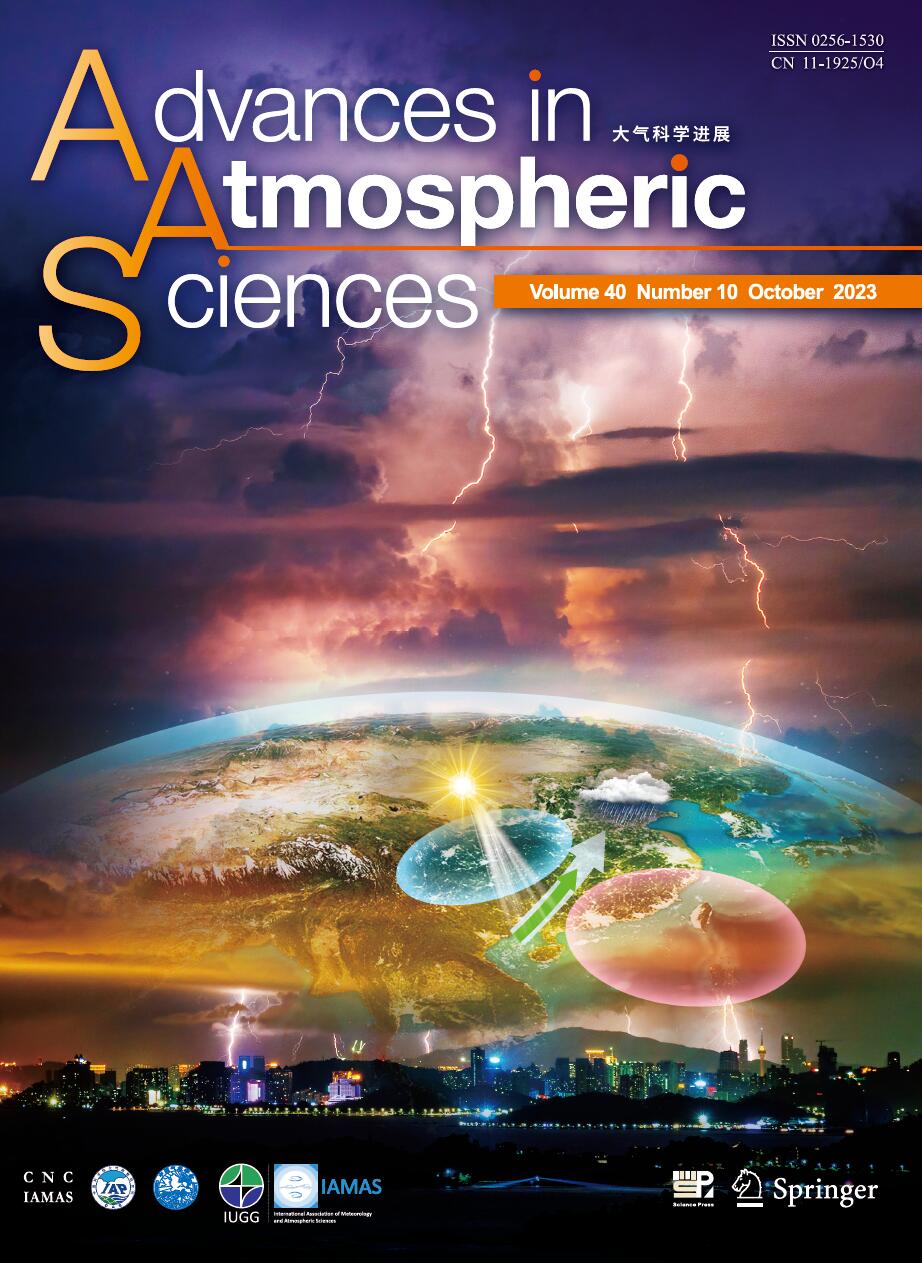| [1] |
Zou Han, Ji Chongping, Zhou Libo, Wang Wei, Jian Yongxiao,
2001: ENSO Signal in Total Ozone over Tibet, ADVANCES IN ATMOSPHERIC SCIENCES, 18, 231-238.
doi: 10.1007/s00376-001-0016-2
|
| [2] |
Zou Han, Gao Yongqi,
1997: Vertical Ozone Profile over Tibet Using Sage I and II Data, ADVANCES IN ATMOSPHERIC SCIENCES, 14, 505-512.
doi: 10.1007/s00376-997-0068-z
|
| [3] |
Hyo-Eun JI, Soon-Hwan LEE, Hwa-Woon LEE,
2013: Characteristics of Sea Breeze Front Development with Various Synoptic Conditions and Its Impact on Lower Troposphere Ozone Formation, ADVANCES IN ATMOSPHERIC SCIENCES, 30, 1461-1478.
doi: 10.1007/s00376-013-2256-3
|
| [4] |
Bian Jianchun, Chen Hongbin, Zhao Yanliang, Lü Daren,
2002: Variation Features of Total Atmospheric Ozone in Beijing and Kunming Based on Dobson and TOMS Data, ADVANCES IN ATMOSPHERIC SCIENCES, 19, 279-286.
doi: 10.1007/s00376-002-0022-z
|
| [5] |
Bo LIU, Juan HUO, Daren LYU, Xin WANG,
2021: Assessment of FY-4A and Himawari-8 Cloud Top Height Retrieval through Comparison with Ground-Based Millimeter Radar at Sites in Tibet and Beijing, ADVANCES IN ATMOSPHERIC SCIENCES, 38, 1334-1350.
doi: 10.1007/s00376-021-0337-2
|
| [6] |
LI Mingwei, WANG Yuxuan*, and JU Weimin,
2014: Effects of a Remotely Sensed Land Cover Dataset with High Spatial Resolution on the Simulation of Secondary Air Pollutants over China Using the Nested-grid GEOS-Chem Chemical Transport Model, ADVANCES IN ATMOSPHERIC SCIENCES, 31, 179-187.
doi: 10.1007/s00376-013-2290-1
|
| [7] |
Hengyi WENG,
2003: Impact of the 11-yr Solar Activity on the QBO in the Climate System, ADVANCES IN ATMOSPHERIC SCIENCES, 20, 303-309.
doi: 10.1007/s00376-003-0017-4
|
| [8] |
CHEN Wen, WEI Ke,
2009: Interannual Variability of the Winter Stratospheric Polar Vortex in the Northern Hemisphere and their Relations to QBO and ENSO, ADVANCES IN ATMOSPHERIC SCIENCES, 26, 855-863.
doi: 10.1007/s00376-009-8168-6
|
| [9] |
Zhang Ren, Yu Zhihao,
2000: Low-Frequency CISK-Rossby Wave and Stratospheric QBO in the Tropical Atmosphere, ADVANCES IN ATMOSPHERIC SCIENCES, 17, 311-321.
doi: 10.1007/s00376-000-0012-y
|
| [10] |
Hailiang ZHANG, Yongfu XU, Long JIA, Min XU,
2021: Smog Chamber Study on the Ozone Formation Potential of Acetaldehyde, ADVANCES IN ATMOSPHERIC SCIENCES, 38, 1238-1251.
doi: 10.1007/s00376-021-0407-5
|
| [11] |
LIU Yu, LI Weiliang, ZHOU Xiuji, I.S.A.ISAKSEN, J.K.SUNDET, HE Jinhai,
2003: The Possible Influences of the Increasing Anthropogenic Emissions in India on Tropospheric Ozone and OH, ADVANCES IN ATMOSPHERIC SCIENCES, 20, 968-977.
doi: 10.1007/BF02915520
|
| [12] |
Liang ZHANG, Bin ZHU, Jinhui GAO, Hanqing KANG,
2017: Impact of Taihu Lake on City Ozone in the Yangtze River Delta, ADVANCES IN ATMOSPHERIC SCIENCES, 34, 226-234.
doi: 10.1007/s00376-016-6099-6
|
| [13] |
XU Jun, ZHANG Yuanhang, WANG Wei,
2006: Numerical Study on the Impacts of Heterogeneous Reactions on Ozone Formation in the Beijing Urban Area, ADVANCES IN ATMOSPHERIC SCIENCES, 23, 605-614.
doi: 10.1007/s00376-006-0605-1
|
| [14] |
A.M.Selvam, M.Radhamani,
1994: Signatures of a Universal Spectrum for Nonlinear Variability in Daily Columnar Total Ozone Content, ADVANCES IN ATMOSPHERIC SCIENCES, 11, 335-342.
doi: 10.1007/BF02658153
|
| [15] |
Junlin AN, Huan LV, Min XUE, Zefeng ZHANG, Bo HU, Junxiu WANG, Bin ZHU,
2021: Analysis of the Effect of Optical Properties of Black Carbon on Ozone in an Urban Environment at the Yangtze River Delta, China, ADVANCES IN ATMOSPHERIC SCIENCES, 38, 1153-1164.
doi: 10.1007/s00376-021-0367-9
|
| [16] |
Lan GAO, Xu YUE, Xiaoyan MENG, Li DU, Yadong LEI, Chenguang TIAN, Liang QIU,
2020: Comparison of Ozone and PM2.5 Concentrations over Urban, Suburban, and Background Sites in China, ADVANCES IN ATMOSPHERIC SCIENCES, 37, 1297-1309.
doi: 10.1007/s00376-020-0054-2
|
| [17] |
Yawei QU, Tijian WANG, Yanfeng CAI, Shekou WANG, Pulong CHEN, Shu LI, Mengmeng LI, Cheng YUAN, Jing WANG, Shaocai XU,
2018: Influence of Atmospheric Particulate Matter on Ozone in Nanjing, China: Observational Study and Mechanistic Analysis, ADVANCES IN ATMOSPHERIC SCIENCES, 35, 1381-1395.
doi: 10.1007/s00376-018-8027-4
|
| [18] |
Junhua YANG, Shichang KANG, Yuling HU, Xintong CHEN, Mukesh RAI,
2022: Influence of South Asian Biomass Burning on Ozone and Aerosol Concentrations Over the Tibetan Plateau, ADVANCES IN ATMOSPHERIC SCIENCES, 39, 1184-1197.
doi: 10.1007/s00376-022-1197-0
|
| [19] |
Xuan MA, Lei WANG,
2023: The Role of Ozone Depletion in the Lack of Cooling in the Antarctic Upper Stratosphere during Austral Winter, ADVANCES IN ATMOSPHERIC SCIENCES, 40, 619-633.
doi: 10.1007/s00376-022-2047-9
|
| [20] |
H. Kurtulus OZCAN, Erdem BILGILI, Ulku SAHIN, O. Nuri UCAN, Cuma BAYAT,
2007: Modeling of Trophospheric Ozone Concentrations Using Genetically Trained Multi-Level Cellular Neural Networks, ADVANCES IN ATMOSPHERIC SCIENCES, 24, 907-914.
doi: 10.1007/s00376-007-0907-y
|















 AAS Website
AAS Website 
 AAS WeChat
AAS WeChat 
 DownLoad:
DownLoad: